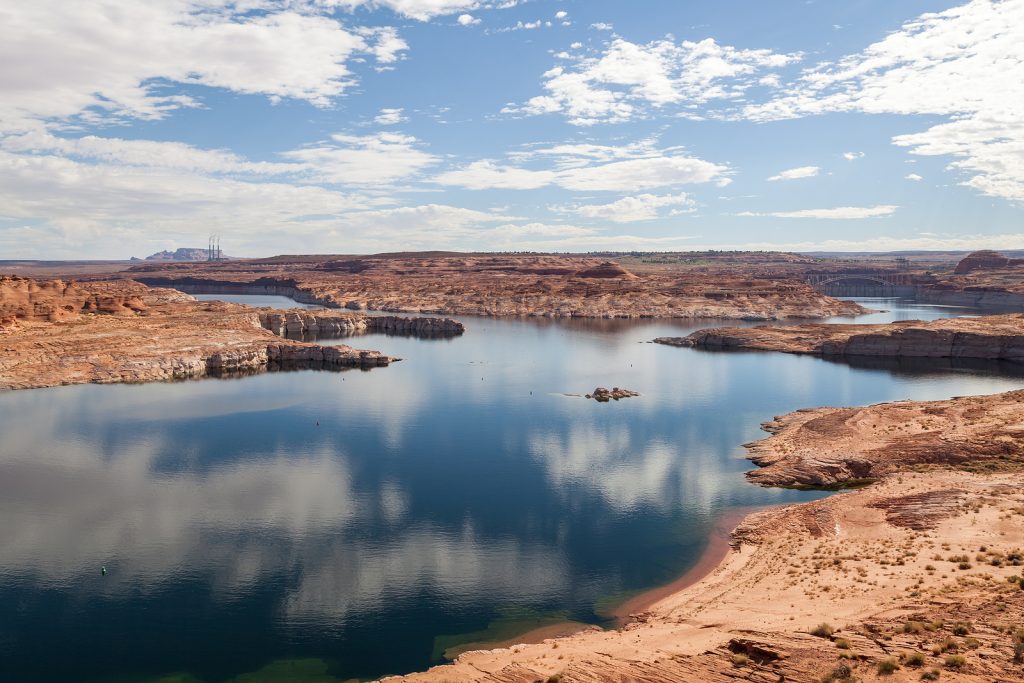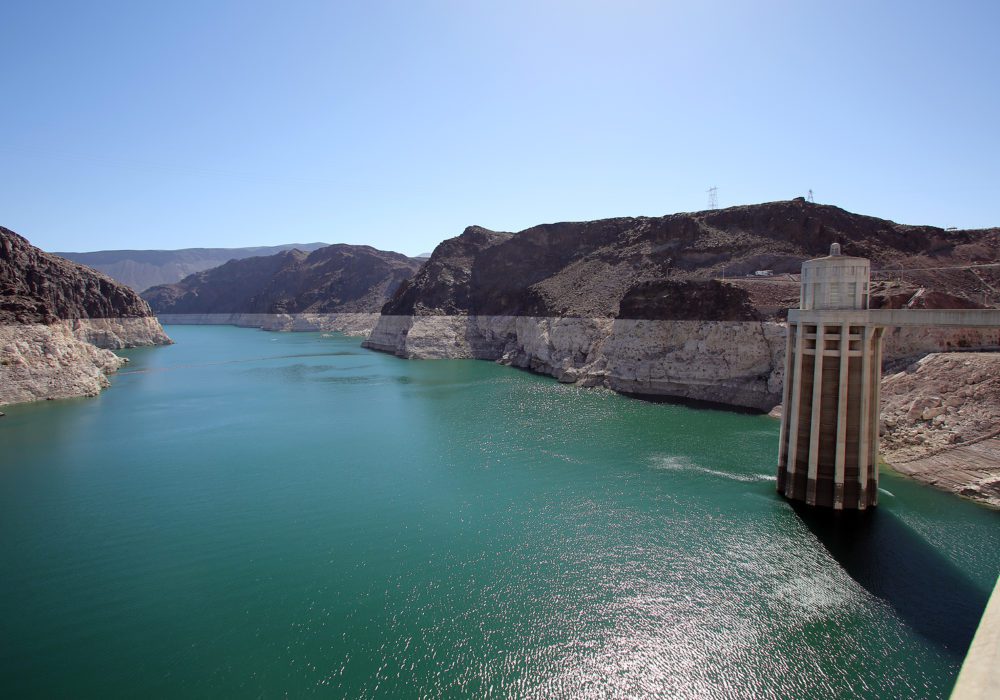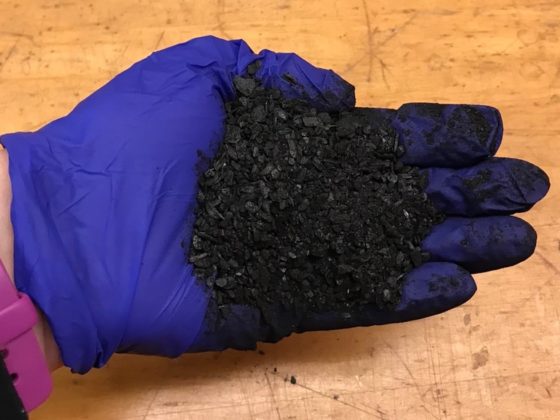In the eighth edition of the Global Water Initiative’s World Water Events, the last event was a talk by Jonathan Overpeck, the Samuel A. Graham Dean of Environmental Sciences at the University of Michigan and its William B. Stapp Collegiate Professor of Environmental Education, titled “Climate Change, The Colorado River and Global Aridification, a High-Confidence Assessment.” The Colorado River Basin is incredibly important, as some 40 to 50 million people directly depend on it for their water. At the same time, this basin that passes through seven states is experiencing severe water stress. The region is in its 22nd year of drought. The two major reservoirs on its way to Mexico—Lake Mead behind the Hoover Dam (see picture above) and Lake Powell formed by Glen Canyon Dam (see picture below) —are at historic lows. They are, respectively, only 40% and 35% full. This situation presents an incredible challenge.

You present a high-confidence assessment of what is happening/is going to happen in the Colorado Basin. This is in and of itself remarkable. Many of us non-climate scientists often have the impression that making predictions about the impact of climate change, especially at a less-than-global level, involves significant uncertainty. If I understand you correctly, you argue that your confidence relates in no small measure to your assessment of the particular type of drought that the Colorado Basin is facing. Can you elaborate?
There are multiple types of drought, but most people think of precipitation deficit over a certain period as defining what a drought is. To me, drought just means “anomalously dry.” And, in the recent history (last 110 years) of the Colorado River, there have been two types of serious multiyear drought in the basin—one in the 1950s–1960s relating mostly to a shortfall in precipitation, and a more recent crisis since the very end of 1990s that related more to anomalously high temperatures. The ’50s–’60s precipitation-dominated drought was likely the norm further back in time, but with the advent of global warming, the more recent drought is of a “hot drought” type that we’ll see increasingly in the future. Multiple studies, including those I’ve been involved in, highlight how increasing temperatures act to reduce river flows via a number of processes. For example, increasing temperatures are increasing the atmospheric demand for moisture, as well as the rate at which water bodies, vegetation, and soils can provide that moisture via evaporation and evapotranspiration. Increasing temperatures are also reducing flows via impacts on snowpack. The “high-confidence” in our projections of continued lower future river flows stems from this well-established temperature-flow link, and the fact that we are virtually certain that continued burning of fossil fuels will continue to warm both the planet and the Colorado River Basin. This contrasts with projections of regional precipitation change where there is more uncertainty. There hasn’t been much observed long-term change in precipitation in the basin, but climate models say there could be either an increase or a decrease. However, even if average precipitation starts to increase, continued increases in temperature are a sure bet unless we stop burning fossil fuels. There will still be precipitation droughts in the future, and during these droughts, the full impact of the increased temperatures will be manifest. Thus, we have high confidence that the future means a continued increased risk of severe drought—and reduced flows—for the Colorado River Basin.
When referring to Lake Mead in your talk, a couple times you mentioned 1,075 feet, the Lake Mead Elevation Threshold. Why is this an important number? What happens if we get under 1,075 feet? Does this have consequences up- or downstream? What can we do?
Going back to the early 20th century, there have been a number of agreements that collectively represent “The Law of the River,” and these policies continue to change slowly through time. However, some principles are more set and rigid than others. For example, it is well established who has senior versus more junior water rights, how much water is allocated to the Upper Basin versus the Lower Basin, as well as to the seven basin states and Mexico. There is also agreement on what constitutes a water shortage and on how the various states and Mexico get their allocation of water cut back if there is a shortage. A first critical threshold for shortage is when the levels in Lake Mead fall below 1,075 feet above sea level. When this happens, the allocation of water to Arizona gets cut back by a pre-agreed significant amount, as do the allocations, to a lesser degree, to Nevada and Mexico. If the lake level falls to lower critical thresholds, then there are further cutbacks in water allocations, including to California. We’ve come close to reaching the 1,075-foot level in multiple years, but we have been saved by unusually high snowfall in the Upper Basin, voluntary water use cutbacks, or increased releases of water from the upstream Lake Powell. Unfortunately, it appears that 2021 is the year the levels will drop below 1,075 feet long enough to trigger the first-ever official shortage on the river.
Note that the Upper Basin states of Colorado, New Mexico, Utah, and Wyoming are not directly affected by the shortage associated with reaching the 1,075-foot level in Lake Mead. However, the Upper Basin must deliver enough water to Lake Powell to meet the power generation requirements to provide cheap electricity for Upper Basin water irrigators. Moreover, over longer periods of time the Upper Basin must deliver a set amount of water to the Lower Basin. In this sense, continued drought and shortage will catch up with the Upper Basin and force the people there to get by with less water. It’s likely that this is in the cards going forward unless we stop climate change and the warming that is reducing river flows.
Toward the end of the talk you mentioned “Global Aridification.” What is this? You also made an interesting, but somewhat alarming, point about its implications for the Amazon and more broadly for “planting trees to fight climate change.” Can you clarify?
When a river or region gets drier, it is getting more arid. Thus, aridification means drying. However, there are many ways to measure drying, and what I’m trying to do is draw attention to the fact that several things are happening in North America, and I believe more widely around the planet, that are driving an aridification trend—all as a consequence of global warming due primarily to the burning of fossil fuels.
As I highlighted in my talk, the flows of water in the Colorado River are going down, primarily as a result of warming temperatures. The same is true for the Rio Grande in New Mexico and farther south. The same is true for the Upper Missouri River. Although other rivers haven’t been studied as much, I strongly suspect river flows are being impacted more and more around the West. All mainly because of warming temperatures.
Also in the West, we’re seeing more drought, more tree and forest mortality, and more severe wildfires. Why? Multiple reasons, but one is that it’s getting warmer, and the warmer temperatures are stressing and killing trees, as well as drying out vegetation and increasing the risk of severe wildfire.
Farther east, out on the High Plains and into the Midwest, what are we seeing? More and more irrigated agriculture. Why? Because rains aren’t reliable enough to support the agricultural demand. Why? Because it’s getting too warm, and just like a backyard garden, farms need more water on the hottest days; and we’re getting more and more hot days. Summer dry spells are now becoming summer droughts, or even severe “flash droughts”—that is, droughts that develop quickly and that have significant impacts.
From the West eastward to the Midwest, we’re also seeing an increasing depletion of fossil, meaning non-renewable, groundwater, as farmers and municipalities turn to groundwater pumping as the only alternative. As the groundwater reaches ever-increasing levels of depletion, it is a harbinger of more arid conditions to come as water supplies dwindle. This process is exacerbated during periods of anomalously low precipitation, which, thanks to increasing temperatures, are becoming more severe droughts, requiring yet more increased, often unsustainable, groundwater use.
Meanwhile, up in the boreal forest of Canada and Alaska, warming is melting permafrost and allowing the water in soils to drain more effectively. This means drier soils and vegetation, and thus more common and severe wildfires.
Everything I’ve described above is driven, at least to some significant extent, by warming, and we know with great confidence why the warming is taking place, and that the warming will continue as long as we burn fossil fuels and emit carbon dioxide and other greenhouse gases into the atmosphere. Thus, it is a high-confidence assessment when we project further aridification in many parts of North America.
Looking more globally, we see the same aridification happening in many parts of the globe. Even in places of increasing precipitation, if a dry spell or drought occurs, it’s likely to last longer and be more severe because temperatures are going up. This has an important implication for forests in many parts of the globe, including the Amazon. Droughts happen, and in the past, forests persisted through these droughts. However, increasingly, dry spells and droughts are much hotter and thus do more damage to trees and forests. This is leading to more forests losing their ability to sequester carbon, and of course, the global increase in severe wildfires means that more carbon and soot is getting injected into the atmosphere due to warming, and this added carbon and soot drives yet more warming, setting up a vicious positive—or amplifying—feedback cycle that accelerates global warming. For example, the Amazon is the largest natural terrestrial carbon sink in the world, but it is becoming less of a sink, and in some cases, it is becoming a net source of carbon to the atmosphere. Simply planting more trees as a solution to global warming is not going to work if those trees, and the forests they are in, don’t remain healthy. This is just another sign of global aridification due to the unrelenting warming that humans have the power to halt.





